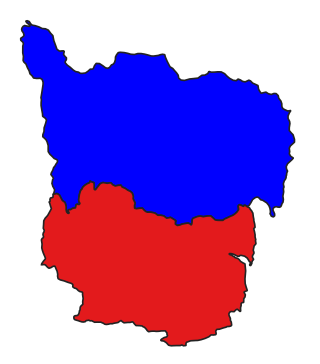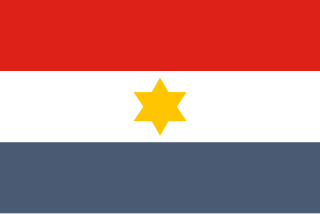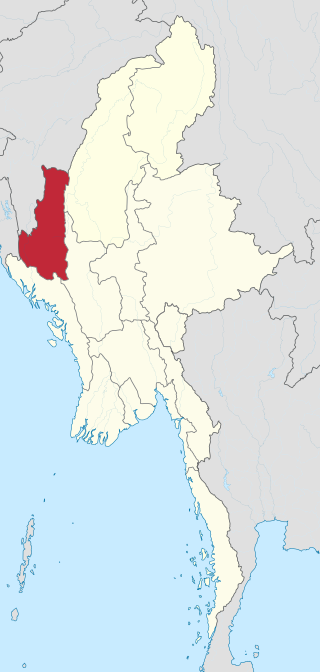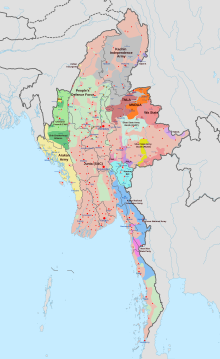
Chin State is a state in western Myanmar. Chin State is bordered by Sagaing Division and Magway Division to the east, Rakhine State to the south, the Chittagong Division of Bangladesh to the west, and the Indian states of Mizoram to the west and Manipur to the north. The population of Chin State is about 488,801 according to the 2014 census, and its capital city is Hakha.

The Chin people are an ethnic group native to the Chin State and Rakhine State of Myanmar. Strictly speaking, the term "Chin" only refers to the 53 sub-tribes of the Chin ethnic group, divided and recognized by the Burmese government. They speak the Kuki-Chin-Mizo languages, which are often mutually unintelligible but are closely related.
Thantlang is a town and the administrative center of Thantlang Township in Chin State, western Myanmar.

Tedim Township is in Tedim District, Chin State of Myanmar (Burma). The administrative centre for the township is the town of Tedim. Tedim Township is the most populous township in Chin State, with a population of 87,623.
Tonzang is a town and the administrative seat of Tonzang Township in Chin State, Myanmar. Tonzang is the second most populous town in Tedim District of Chin State.
The Lai people mainly inhabit the southern parts of Chin Hills in Myanmar's Chin State, in the townships of Falam, Thantlang and Hakha. They are also found in the Lawngtlai district of Mizoram, India, where they have been granted the Lai Autonomous District Council. Outside this area they are scattered in Mizoram and in Manipur. Their languages "Laizo Lai" and "Hakha Lai" are classified as Central Kuki-Chin languages.
The Kuki-Chin-Mizo languages are a branch of the Sino-Tibetan language family spoken in northeastern India, western Myanmar and southeastern Bangladesh. Most notable Kuki-Chin-speaking ethnic groups are referred to collectively as the Zo people which includes: the Mizo of Mizoram, the Kuki of Manipur, Assam, Nagaland, Tripura and Bangladesh and the Chin of Chin State, Myanmar.
Chin Christian Institute of Theology, also known as CCIT, is situated in Falam, Chin State, Myanmar. It is a school run by Chin Baptist Convention, which belongs to Myanmar Baptist Convention.

The Zomi Revolutionary Army (ZRA) is an armed Zomi nationalist militant group formed in 1997, following an increase in ethnic tensions between the Kuki people and the Paites tribe in Churachandpur district of Manipur, India. Its parent organisation, the Zomi Re-unification Organisation, was founded in April 1993.

The Chin National Front is a Chin nationalist political organization in Myanmar. According to its website, its armed wing, the Chin National Army (CNA), fights the government of Myanmar. The group was founded on 20 March 1988. This organization claims to seek a Federal Union based on self-determination, ethnic equality and democracy. The Chin people are one of the four founding members of the Union of Burma. In 2021, CNF became a member of the National Unity Consultative Council.

Chin Baptist Convention is a Baptist Christian denomination Myanmar. The headquarters is in Falam, Chin State, Myanmar. It is a member of the Myanmar Baptist Convention.

The Chin National Army is a Chin ethnic armed organisation in Myanmar (Burma). It is the armed wing of the Chin National Front (CNF), and was founded on 20 March 1988 alongside it. The CNA signed a ceasefire agreement with the government of Myanmar on 6 January 2012.

The Myanmar civil war, also called the Burmese Spring Revolution, Burmese civil war or People's Defensive War, is an ongoing civil war following Myanmar's long-running insurgencies, which escalated significantly in response to the 2021 military coup d'état and the subsequent violent crackdown on anti-coup protests. The exiled National Unity Government and major ethnic armed organisations repudiated the 2008 Constitution and called instead for a democratic federal state. Besides engaging this rebel alliance, the junta also contends with other anti-junta forces in areas under its control. Hannah Beech of The New York Times observed the insurgents are apportioned into hundreds of armed groups scattered across the country.

The Chinland Defense Force is a rebel group in Myanmar. It was formed in response to the 2021 Myanmar coup d'état to protect Chin State from the military junta. The CDF claims that they do not attack the military without cause and that they always issue a warning, such as releasing detainees and refraining from using violence against civilians. If the military does not respond, guerrilla or other action follows. They promise to return their weapons and disband if the revolution is successful. CDFs are members of CJDC. Chinland Joint Defense Committee (CJDC) is formed to serve Chin people's security services and protect an enemy from the illegal Myanmar Army. The total strength of active personnel under the command of CJDC is approximated to be around 15,000. From August to October 2021, it was reported that at least 40 clashes occurred between junta troops and CDF in various townships. CJDC claimed that at least 1,029 Tatmadaw soldiers were killed in the clashes and lost 58 of their own in 2021.

The Chin theater is one of the theaters of the Myanmar civil war (2021–present), with resistance forces fighting against the Tatmadaw military junta in Chin State, western Myanmar.

The Chinland Council is the legislature of the self-governing polity the State of Chinland. It was formed on 6 December 2023 following the adoption of the Chinland Constitution by the Chinland Convention that was ratified by 235 representatives of various Chin communities from the Chin State. The Chinland Council has 112 members variously from: the Chin National Front (CNF) (27), Chin officials elected for the now dissolved Pyidaungsu Hluttaw (17), and local administration organizations (68).
Sui Khar is a prominent Chin scholar, revolutionist, and ethnic rights advocate. He presently serves as foreign minister of the newly formed Chin State Government, having been nominated by the Chinland Council on 1 February 2024 and as Vice-chairman 2 of the Chin National Front (CNF).
The ongoing Myanmar civil war has had a spillover into other countries, especially India and Bangladesh.
The Chin Brotherhood Alliance (CBA) is a military and political alliance between several ethnic armed organisations active in Chin State, Myanmar. Formed on 30 December 2023 during the Myanmar civil war, the claimed goal of the alliance is to foster collaboration concerning affairs in Chin State and in the Chin ethnic community. The alliance was created by local Chin people's defence forces who believed that the establishment of the Chinland Constitution, the Chinland Council, and the State of Chinland "did not adhere to democratic standards, lacked equality, and failed to represent and reflect the unity of the entire Chin ethnic group."

Tedim District is a district located in Myanmar state of Chin State with a Myanmar Census 2014 population of 117,393, making it the most populous district in Chin State. On May 1, 2022, Tedim District was formed with Tedim and Tonzang townships. Its district seat is Tedim. The major towns are Tedim, Tonzang, Cikha, and Khaikam. Most people in Tedim District called themselves Zomi.
















